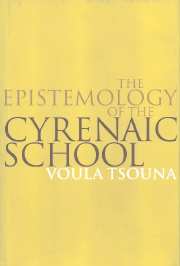Book contents
- Frontmatter
- Contents
- Preface
- Abbreviations
- 1 Knowledge and the good life: the ethical motivation of the Cyrenaic views on knowledge
- PART I SUBJECTIVISM
- 2 The nature of the pathē
- 3 The vocabulary of the pathē
- 4 The apprehension of the pathē
- 5 The criticism of Aristocles of Messene
- PART II SCEPTICISM
- PART III SUBJECTIVISM, EMPIRICISM, RELATIVISM: CYRENAICS, EPICUREANS, PROTAGOREANS
- Appendix: Sources and testimonies
- References
- Index of names
- Index locorum
- Subject index
5 - The criticism of Aristocles of Messene
Published online by Cambridge University Press: 22 September 2009
- Frontmatter
- Contents
- Preface
- Abbreviations
- 1 Knowledge and the good life: the ethical motivation of the Cyrenaic views on knowledge
- PART I SUBJECTIVISM
- 2 The nature of the pathē
- 3 The vocabulary of the pathē
- 4 The apprehension of the pathē
- 5 The criticism of Aristocles of Messene
- PART II SCEPTICISM
- PART III SUBJECTIVISM, EMPIRICISM, RELATIVISM: CYRENAICS, EPICUREANS, PROTAGOREANS
- Appendix: Sources and testimonies
- References
- Index of names
- Index locorum
- Subject index
Summary
The restricted scope of the Cyrenaic criterion constitutes the target of the Peripatetic philosopher Aristocles of Messene, whose criticism of the Cyrenaic theory is reported by Eusebius.
At the outset, Aristocles sketches out the theory which he intends to attack in the following terms.
Next are those who claim that only the pathē are apprehensible; this was maintained by some philosophers from Cyrene. These philosophers maintained that they know absolutely nothing, just as if a very deep sleep weighs down on them, unless somebody standing beside them struck them or pricked them. For they said that, when they are being burnt or cut they know that they are undergoing something. But whether the thing which is burning them is fire or that which is cutting them is iron they cannot tell.
(Eusebius xiv.19.1 [T5])Aristocles' objections are not targeted against the affirmation that the pathē are apprehensible, but against the restrictive claim that only they can be apprehended. His goal is to show that the Cyrenaic position is inconsistent by arguing that we know many things in addition to our pathē, or that our awareness of pathē entails (or presupposes) that we know things about external objects.
- Type
- Chapter
- Information
- The Epistemology of the Cyrenaic School , pp. 62 - 72Publisher: Cambridge University PressPrint publication year: 1998



